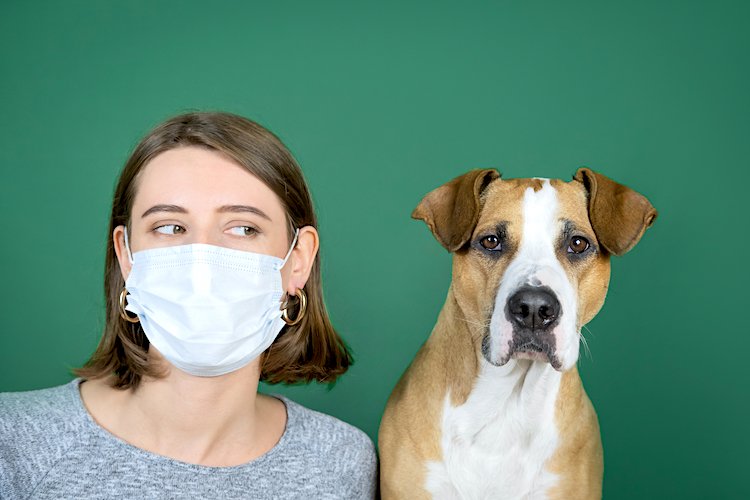Going to the Vet During COVID-19: Is It Essential?
Don’t expect to be able to simply walk into the veterinary clinic with your pet. Here’s what to know about going to the vet during the COVID-19 pandemic.

Sitting at home with nothing to do? Thinking about going to the vet during the COVID-19 pandemic? Please think again.
Veterinary hospitals are considered essential services, but is your visit really essential? To you or your pet? Right now?
You need to make the decision: Go out in public and take a trip to the veterinarian at the height of the coronavirus outbreak, or stay at home and help flatten the curve. Your way to help the pandemic in the United States right now is to stay home whenever possible.
I have been working in a coronavirus hot spot, the New York City area. My last day of work was March 18, and I self-quarantined once I left work but got sick 11 days into that quarantine.
I’m feeling like I have the flu, can’t get tested easily (nor should I), and am staying at home and taking good care of myself. I should be fine.
Because nobody was taking this seriously enough 1–2 months ago, we were all unnecessarily exposing each other as veterinarians like myself cared for your pets and you cared for them by bringing them in. But we know more now and can act more safely.
This has really hit home for me, if you will. My friends and family continue to work on the front lines in the health professions. They are ICU doctors and nurses in New York hospitals. One friend died recently in the hospital.
None of what I share here is meant to scare anybody or place fear. It is, however, a message for anyone who is not living in the middle of a hot spot right now. What you do today can help your community in the coming months.
Veterinary staffs are challenged. We want to keep the doors open and deliver essential services, but guidelines are not written in stone since this is new territory for everyone. Even the corporate veterinary chains have no clear policies.
Here are some of the things to expect if you need to go to the vet during the high point of the COVID-19 pandemic.

Don’t leave your pet’s safety to chance
Sign up for Petful recall alerts today.

Call Ahead
Call your veterinary clinic to discuss your pet’s needs or medical problem.
Your vet may not be willing to see routine things or things that can be postponed. Don’t expect to be able to walk into your vet office. Social distancing prohibits this right now.
How Essential Is Your Trip to the Vet?
Does your vet think it is essential for you to bring your pet in?
If the answer is yes, then should you go outside right now?
Decide if it is safe and prudent for you to take the trip to the vet. Ask yourself the following questions:
- Are you in a high-risk group?
- Are you feeling sick?
- Have you been in contact with a positive individual?
- Do you live in a heavily affected area?
Your Vet May Screen You and Your Appointment
To ensure the safety of all, your vet may call you 24 hours before your appointment to ask you some personal questions. Please answer honestly.
- Have you been tested positive for COVID-19?
- Are you feeling ill?
- Have you been in close contact with a positive COVID-19 person?
If you answer yes to any of these questions, your pet will be treated with more precautions by the veterinary staff and you will be asked to stay at home and have someone else transport the pet to the vet.
Veterinary Medicine as an Essential Service
Small animal vets are considered “essential” for a number of reasons:
- To administer rabies vaccines
- For emergency pet situations
- To maintain the human–animal bond
Supporting the human–animal bond is particularly important in times of crisis. Many people are experiencing extreme stress, isolation and loneliness. Their pet may be their only connection to normalcy right now.
If anything happens to that pet and they do not get veterinary care, the pet’s guardian could be overcome with guilt and despair. Vets are important for your pet’s health and for your well-being!
That being said, many veterinary services are not considered essential at this time. Think about doing anything to avoid a face-to-face veterinary visit right now.

Limited Hours and Social Distancing
Your veterinary hospital may be making many changes:
- Social distancing: Some hospitals with small waiting rooms or exam rooms cannot have people be 6 feet apart. You may be asked to stay outside the clinic altogether.
- Limited hours: Some hospitals are trying to break their staff into teams so that if one person becomes sick, it does not mean that all employees were exposed to that person. Other hospitals already have some staff members who are sick. In some areas like Hoboken, New Jersey, where I was working, an 8 p.m. curfew was put in place several weeks ago requiring the clinic to close a little early.
- Closed waiting rooms: You may be asked to wait in the parking lot or be offered a curbside pickup. In New York, most people do not drive to the vet, so they must be prepared to stay outside while their pet is being treated or drop their pet off and return later.
- Inability to be with your pet for the exam: The easiest way to maintain proper social distancing is to get a history over the phone, take the pet away from their person at the clinic door, and complete the exam without the person in the hospital.
I can tell you from personal experience that people “forget” the social distancing when they are in the room with their beloved pet. It’s natural to want to “show” me something — but before you know it, they are rushing to the exam table and getting too close or bringing up a video of the pet on their phone and breaking the 6-foot social distance to show me the video.
Best practice dictates that a masked and gloved veterinary technician holds the pet while the masked and gloved veterinarian examines the pet in a larger area with better air circulation than most exam rooms.
In addition, electronic payments only has been suggested.
Limited Services
Many clinics are cutting down on wellness appointments. Call ahead and see if your pet’s wellness needs can be postponed until after the height of the pandemic.
Puppies should receive their important first vaccinations.
Emergency surgeries and some elective surgeries are being done at most hospitals. If your hospital can’t handle something, referral hospitals are generally in full operation for acute or emergency needs.
Telemedicine
Many clinics are offering veterinary telemedicine appointments. Zoom has come in very handy!
Although some problems affecting your pet may need to be seen in person, many appointments can be done via telemedicine.
Caring for the Pet From an Infected Household
A pet coming from an infected home may have coronavirus present on their fur and through oral secretions. Your vet may wish to pat down the pet’s coat with a solution that can kill the virus and avoid close contact with the pet’s face.
Vets working on these pets will want to wear more personal protective equipment (PPE). For ethical considerations, vets are trying to conserve their PPE because of the shortage. If a pet from an infected household can wait for treatment, it is safer for everyone and it conserves PPE.
It has been strongly advised to avoid anesthetizing or doing dental procedures on these pets at this time. If necessary, N95 respirator masks and facial shields should be used, and most veterinarians don’t have these.
In this video, Dr. Sara Meiggs, DVM, explains more about going to the vet during COVID-19:

Think Ahead
Your veterinary staff is trying hard to limit person-to-person exposure while still caring for your pet. Medications can still be filled and dispensed, and food can be delivered to you at the front door of the clinic or to your doorstep.
These are not normal times, however. Many services are delayed.
Regular pharmacies, online pharmacies and the food companies are under duress trying to meet the demand right now.
Your vet is also under strain trying to work from a distance, calling in new prescriptions, trying to follow local and state guidelines, checking medical records remotely, etc. Everything is taking more time and everyone is feeling the stress.
We can all do our part by prioritizing our pets’ needs along with the help of your veterinary staff. If you have to go to the vet, you have every right to go.
But keep one thing in mind if you think a nonessential trip to the vet might be a nice diversion: You might be driving to the vet and be seen by a nurse, doctor or first responder who has just finished a harrowing 12-hour shift. They’re thinking, “Why is this person in their car right now? Is their trip essential?”
The nurse and doctor are headed home to leave their clothes outside their house and self-quarantine in their basement, garage or car until their next shift so as not to expose their family. We need to think of them right now, too.
References
- Samuel, Sigal. “How You Can Keep Thousands of People From Getting Coronavirus, in One GIF.” Vox. March 26, 2020. https://www.vox.com/future-perfect/2020/3/26/21193851/coronavirus-covid-19-staying-home-social-distancing.
- Katz, Josh, et al. “Coronavirus in the U.S.: How Fast It’s Growing.” The New York Times. April 4, 2020. https://www.nytimes.com/interactive/2020/04/03/upshot/coronavirus-metro-area-tracker.html.
- Shear, Michael D., et al. “The Lost Month: How a Failure to Test Blinded the U.S. to COVID-19.” The New York Times. March 28, 2020. https://www.nytimes.com/2020/03/28/us/testing-coronavirus-pandemic.html.
- Jasny, Michelle Gerhard, VMD. “Visiting Vet: Veterinary Care During Coronavirus.” Martha’s Vineyard Times. March 25, 2020. https://www.mvtimes.com/2020/03/25/visiting-vet-veterinary-care-coronavirus/.
- “People Who Are at Higher Risk for Severe Illness.” Centers for Disease Control and Prevention. https://www.cdc.gov/coronavirus/2019-ncov/need-extra-precautions/people-at-higher-risk.html.
- “Symptoms of Coronavirus.” Centers for Disease Control and Prevention. https://www.cdc.gov/coronavirus/2019-ncov/symptoms-testing/symptoms.html.
- “Cases in U.S.” Centers for Disease Control and Prevention. https://www.cdc.gov/coronavirus/2019-ncov/cases-updates/cases-in-us.html.
- “What to Do If You Were Potentially Exposed to Someone With Confirmed Coronavirus Disease (COVID-19).” Washington State Department of Health. March 17, 2020. https://www.doh.wa.gov/Portals/1/Documents/1600/coronavirus/COVIDexposed.pdf.
- “Human–Animal Bond.” American Veterinary Medical Association. https://www.avma.org/one-health/human-animal-bond.
- “The Power of Pets: Health Benefits of Human–Animal Interactions.” National Institutes of Health (NIH) News in Health. February 2018. https://newsinhealth.nih.gov/2018/02/power-pets.
- “Coronavirus Social Distancing: How Far Away Is 6 feet?” KGO-TV San Francisco. March 27, 2020. https://abc7news.com/coronavirus-6-feet-social-distancing-spread/6053554/.
- Rooney, Kate. “Electronic Payments Look More Appealing as People Fear Cash Could Spread Coronavirus.” CNBC. March 16, 2020. https://www.cnbc.com/2020/03/16/electronic-payments-look-more-appealing-as-coronavirus-spreads.html.
- “Veterinary Medicine in the Age of COVID-19.” Texas A&M University College of Veterinary & Biomedical Sciences. April 2, 2020. https://vetmed.tamu.edu/news/pet-talk/veterinary-telemedicine-in-the-age-of-covid-19/.
- Lorenz, Taylor, et al. “We Live in Zoom Now.” The New York Times. March 17, 2020. https://www.nytimes.com/2020/03/17/style/zoom-parties-coronavirus-memes.html.
- Chaib, Fadela. “Shortage of Personal Protective Equipment Endangering Health Workers Worldwide.” World Health Organization. March 3, 2020. https://www.who.int/news-room/detail/03-03-2020-shortage-of-personal-protective-equipment-endangering-health-workers-worldwide.
- Arnett, Dugan. “For Physicians and Nurses on the Front Line, There’s Worry Over Bringing Coronavirus Home.” Boston Globe. March 20, 2020. https://www.bostonglobe.com/2020/03/20/nation/physicians-nurses-front-line-theres-worry-over-bringing-coronavirus-home/.







